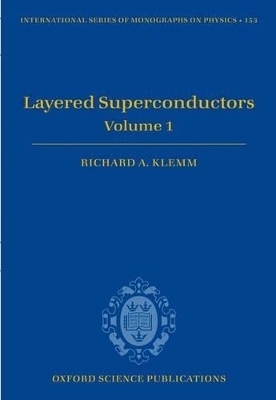
Layered Superconductors
Volume 1
Seiten
2011
Oxford University Press (Verlag)
978-0-19-959331-6 (ISBN)
Oxford University Press (Verlag)
978-0-19-959331-6 (ISBN)
This book provides a comparison of the different chemical structures, normal state properties, and simplest superconducting properties of all known classes of layered superconductors. It introduces the three phenomenological models used to describe such systems, and will guide young researchers hoping to produce a room-temperature superconductor.
Since the discovery by the author and collaborators of superconductivity in the first truly layered compound, TaS2(pyridine)1/2, there have been many types of layered superconductors. These include the graphite intercalation compounds, the transition metal dichalcogenides, the intercalated transition metal dichalcogenides, the organic layered superconductors, the high-temperature cuprates, the various types of artificial multilayers, strontium ruthenate, magnesium diboride, the ternary intermetallics, the quaternary intermetallics or borocarbides, the iron pnictides and oxypnictides, the iron chalcogenides, and the intercalated metal nitride halides. In the development of this huge field, an underlying theme has always been to try to develop a room-temperature superconductor. Since most of the superconductors with the highest transition temperatures are layered, this book compares and contrasts the wide variety of materials and their properties. It should serve as a guide for young experimentalists hoping to make a room-temperature superconductor.
In addition, the book presents the three classes of phenomenological theoretical descriptions of layered superconductors: the anisotropic London model, the anisotropic Ginzburg-Landau model, and the Lawrence-Doniach model specifically developed to treat layered superconductors. Calculations using these models for the upper and lower critical fields are presented in detail, accessible to graduate students wanting to learn the basics of widely-used theoretical descriptions.
Since the discovery by the author and collaborators of superconductivity in the first truly layered compound, TaS2(pyridine)1/2, there have been many types of layered superconductors. These include the graphite intercalation compounds, the transition metal dichalcogenides, the intercalated transition metal dichalcogenides, the organic layered superconductors, the high-temperature cuprates, the various types of artificial multilayers, strontium ruthenate, magnesium diboride, the ternary intermetallics, the quaternary intermetallics or borocarbides, the iron pnictides and oxypnictides, the iron chalcogenides, and the intercalated metal nitride halides. In the development of this huge field, an underlying theme has always been to try to develop a room-temperature superconductor. Since most of the superconductors with the highest transition temperatures are layered, this book compares and contrasts the wide variety of materials and their properties. It should serve as a guide for young experimentalists hoping to make a room-temperature superconductor.
In addition, the book presents the three classes of phenomenological theoretical descriptions of layered superconductors: the anisotropic London model, the anisotropic Ginzburg-Landau model, and the Lawrence-Doniach model specifically developed to treat layered superconductors. Calculations using these models for the upper and lower critical fields are presented in detail, accessible to graduate students wanting to learn the basics of widely-used theoretical descriptions.
Richard Klemm, with collaborators, discovered layered superconductors while working as a research technician at Synvar Research Institute in Palo Alto. He went on to write his doctoral thesis on the subject, and has since had a distinguished career working in various fields within condensed matter physics, with visiting professorships at numerous American universities, and positions at the National Laboratories. He is a fellow and outstanding referee of the American Physical Society.
1. Introduction ; 2. Layered Superconducting Materials ; 3. Fermi Surfaces ; 4. Normal State Properties ; 5. Relevant Lengths ; 6. Phenomenological Models ; 7. Upper Critical Field ; 8. Lower Critical Field
| Reihe/Serie | International Series of Monographs on Physics ; 153 |
|---|---|
| Zusatzinfo | 300 b/w line and halftone illustrations |
| Verlagsort | Oxford |
| Sprache | englisch |
| Maße | 184 x 250 mm |
| Gewicht | 1078 g |
| Themenwelt | Naturwissenschaften ► Chemie ► Physikalische Chemie |
| Naturwissenschaften ► Physik / Astronomie ► Angewandte Physik | |
| Naturwissenschaften ► Physik / Astronomie ► Elektrodynamik | |
| Naturwissenschaften ► Physik / Astronomie ► Festkörperphysik | |
| Naturwissenschaften ► Physik / Astronomie ► Thermodynamik | |
| Technik ► Maschinenbau | |
| ISBN-10 | 0-19-959331-0 / 0199593310 |
| ISBN-13 | 978-0-19-959331-6 / 9780199593316 |
| Zustand | Neuware |
| Informationen gemäß Produktsicherheitsverordnung (GPSR) | |
| Haben Sie eine Frage zum Produkt? |
Mehr entdecken
aus dem Bereich
aus dem Bereich
Quantenmechanik | Spektroskopie | Statistische Thermodynamik
Buch | Softcover (2024)
De Gruyter (Verlag)
CHF 83,90
Thermodynamik | Kinetik | Elektrochemie
Buch | Softcover (2024)
De Gruyter (Verlag)
CHF 83,90
Set aus Lehrbuch und Arbeitsbuch
Buch | Hardcover (2022)
Wiley-VCH (Verlag)
CHF 149,95


